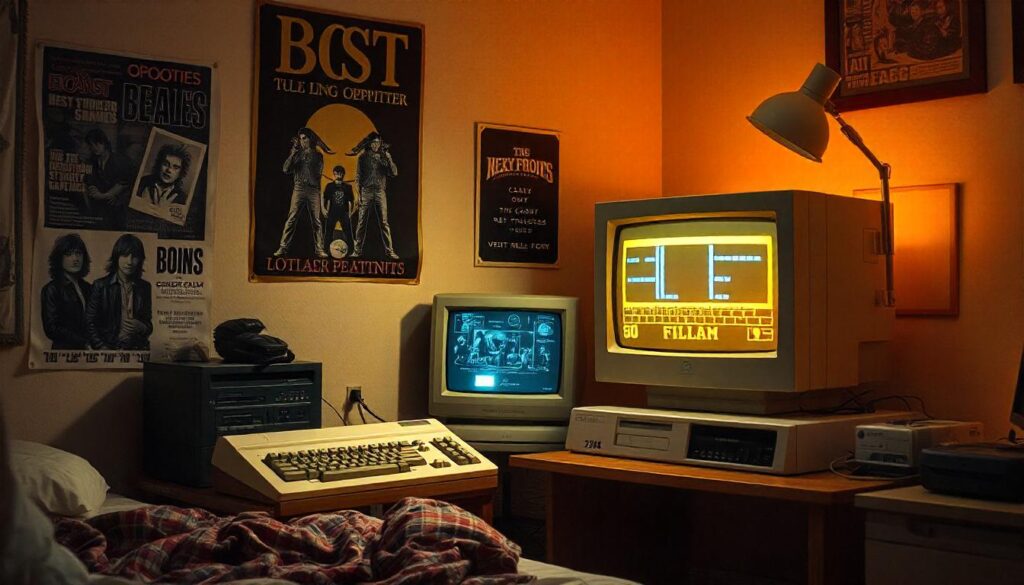Introduction
The 1980s were a magical decade that witnessed the birth of technological wonders that have since become ingrained in the fabric of our lives. It was an era where the hum of innovation could be heard in every corner, from the clunky, neon-colored gadgets to the sleek, revolutionary devices that felt like they were pulled straight from the future. As we reflect on those years, the nostalgia that floods our hearts is a reminder of how the tech of that time laid the foundation for the cutting-edge technology we use today.
There was something uniquely charming about the 80s, a time when the world seemed on the verge of major change, yet still held on to the analog ways of the past. It was the dawn of personal computing, the rise of mobile communication, and the era when music truly became portable. With each new invention, it felt as though we were stepping into the future with excitement and wonder.
Portable CD Players: The Soundtrack of Our Lives
One of the standout gadgets of the 80s was undoubtedly the portable CD player. These little machines were nothing short of a revolution. Before the 80s, we had cassette tapes and Walkmans, which allowed us to carry our music around. But the introduction of the compact disc (CD) in the early 80s changed everything. It promised clearer sound, greater durability, and a higher capacity for music than any cassette tape could ever provide.
In 1984, Sony introduced the first portable CD player, the D-50, and it was an instant hit. For the first time, music lovers could carry around their entire album collection without worrying about the wear and tear of tapes or the fuzziness of radio stations. The sleek, metallic design of the CD players, along with the signature “skip protection” feature, made them a symbol of modernity. With the press of a button, a world of music was right there in the palm of our hands. For those of us who grew up in that era, the sound of the CD player skipping across the sidewalk during a walk down the street is forever etched in our memories.
Mobile Phones: The Beginning of Always Being Connected
Before the 80s, phones were strictly stationary devices. But with the rise of mobile phones in the 80s, the world began to shrink in ways we couldn’t have imagined. The first commercial mobile phone, the Motorola DynaTAC 8000X, was released in 1983. It was massive, bulky, and incredibly expensive, but it was also a symbol of freedom and convenience. The DynaTAC, which weighed nearly two and a half pounds, was a far cry from today’s sleek, pocket-sized smartphones. But to hold one of those early phones in your hand was to hold a piece of the future.
The DynaTAC allowed people to make calls from virtually anywhere, and although the phone’s limited battery life and high cost kept it out of the hands of most, it marked the beginning of a world where we would soon be connected at all times. Those first mobile phones were the foundation for the powerful devices we carry today—sleek, multifunctional tools that offer not just voice calls, but access to information, entertainment, and so much more.
The Walkman: Personal Music for Everyone
Before the Walkman, listening to music on the go was a bit of a challenge. You had to sit near a radio or drag around a boombox if you wanted to take your tunes with you. But in 1979, Sony introduced the Walkman, and by the time the 80s arrived, it became the soundtrack to a generation. It wasn’t just a portable cassette player; it was a lifestyle. The Walkman was the epitome of freedom—it allowed people to block out the world and immerse themselves in music wherever they went. Whether it was at the gym, on a walk, or during a long commute, the Walkman offered an escape from reality.
It was the first truly personal music device, allowing people to carry their favorite songs with them everywhere. The sleek design and innovative portability made the Walkman a staple of the 80s. The impact of the Walkman is still felt today in how we consume music—through personal, portable devices like iPods, smartphones, and streaming services.
Personal Computers: The Dawn of the Digital Age
While the 80s are remembered for their flashy gadgets, perhaps no device had a greater impact on the future than the personal computer. Before the 80s, computers were massive, costly machines that took up entire rooms. But in the early part of the decade, companies like Apple and IBM began producing computers for the average consumer. Apple’s Macintosh, released in 1984, was the first computer with a graphical user interface, making it more intuitive and accessible for everyone. The introduction of the IBM PC in 1981 also made personal computers more affordable and available to a wider audience.
The personal computer revolutionized the way we worked, learned, and communicated. It laid the groundwork for the digital age, as we slowly transitioned from an analog world to a digital one. It wasn’t just the computers themselves that were revolutionary, but the software and applications that began to flourish alongside them. The 80s saw the rise of home computing, a trend that only continued to grow as the decade came to a close.
Video Game Consoles: Entering New Realms of Entertainment
While today’s gaming consoles boast high-definition graphics and immersive experiences, the 80s marked the birth of the video game industry as we know it. The Atari 2600, released in 1977, had already made a mark on the gaming world, but the 1980s were the golden age of home consoles. In 1983, the Nintendo Entertainment System (NES) was released, followed by the Sega Master System. These consoles gave rise to iconic video games like Super Mario Bros., The Legend of Zelda, and Pac-Man, which became household names and still hold a place in our hearts.
The 80s was the era when gaming went from a niche hobby to a mainstream activity. People gathered around their TV sets, controller in hand, ready to dive into a world of adventure, strategy, and competition. It was during this time that the idea of immersive, interactive entertainment took hold—a concept that remains at the heart of today’s gaming industry.
Conclusion: The Legacy of the 80s
The gadgets of the 80s were more than just technology; they were symbols of possibility. They represented the hope and excitement of a new era, one where anything seemed possible. The portable CD players, mobile phones, Walkmans, personal computers, and video game consoles of the 80s laid the groundwork for the devices we take for granted today. They were the pioneers that set the stage for the technological marvels we now use every day.
As we look back on the 80s, it’s impossible not to feel a sense of gratitude for the gadgets that changed our lives. They didn’t just give us convenience—they gave us a glimpse of the future. And while the technology may have evolved, the sense of wonder and excitement that we felt during that time still holds true today. The 80s were more than just a decade; they were a defining moment in the history of technology, one that continues to shape the world we live in.
4o mini


